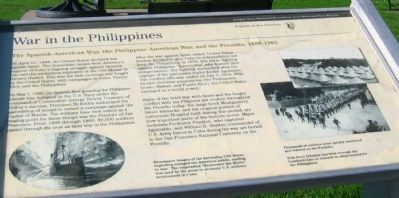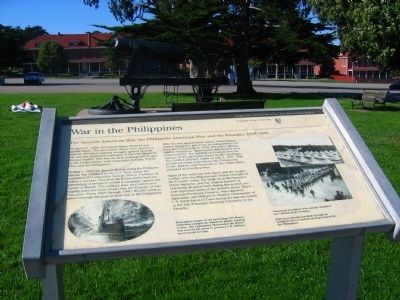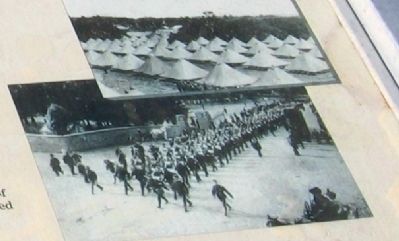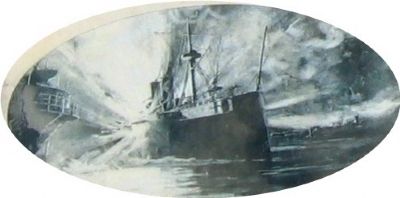Main Post in San Francisco City and County, California — The American West (Pacific Coastal)
War in the Philippines
The Spanish-American War, the Philippine-American War, and the Presidio
— 1898 – 1902 —
On May 18, 1898, the Spanish fleet guarding the Philippine Islands was defeated by the U.S. Navy under the command of Commodore George Dewey. Unaware of Dewey’s success, President McKinley authorized the assembling of troops to mount a campaign against the capital of Manila. The military base best suited the as a staging point for these troops was the Presidio of San Francisco. From 1898 through 1900, 80,000 soldiers passed through the post on their way to the Philippines.
After the was against Spain ended, United States leaders decided to give Cuba its independence but keep the Philippines. In 1899, this led to fighting against Philippine “Insurrectos” who wanted their independence. The fighting diminished after the capture of the nationalist leader Emilio Aguinaldo. The conflict officially ended on July 4, 1902. With its new overseas possessions (the Philippines, Guam, Hawaii, and Puerto Rico), the United States emerged as a world power.
Signs of the brief war with Spain and the longer conflict with the Filipinos are evident throughout the Presidio today: the large brick Montgomery Street barracks, and the original portion of Letterman Hospital built during that period, are now important parts of the historic scene. Major Generals Frederick Funston, who captured Aguinaldo, and William R. Shafter, commander of U.S. Army forces in Cuba during the war, are buried in the San Francisco National Cemetery on the Presidio.
Erected by National Park Service, U.S. Department of the Interior.
Topics and series. This historical marker is listed in these topic lists: Military • Notable Events • Notable Places • War, Spanish-American. In addition, it is included in the Former U.S. Presidents: #25 William McKinley series list. A significant historical date for this entry is April 21, 1898.
Location. 37° 47.986′ N, 122° 27.47′ W. Marker is in San Francisco, California, in San Francisco City and County. It is in Main Post. Marker can be reached from Graham Street. Marker is located at Pershing Square, Moraga Avenue and Graham Streets. Touch for map. Marker is in this post office area: San Francisco CA 94123, United States of America. Touch for directions.
Other nearby markers. At least 8 other markers are within walking distance of this marker. The Ordońez Gun (here, next to this marker); Sixth Army Headquarters (about 300 feet away, measured in a direct line); Ammunition Magazine
(about 400 feet away); Infantry Row (about 400 feet away); Pershing Square (about 500 feet away); Montgomery Street Barracks (about 500 feet away); Outpost of an Empire (about 500 feet away); North West Corner of Original Presidio (about 600 feet away). Touch for a list and map of all markers in San Francisco.
Regarding War in the Philippines. Also see: The Ordonez Gun marker for additional information.
Also see . . .
1. The Spanish American War “A Splendid Little War”. (Submitted on October 18, 2008.)
2. The Philippine War - A Conflict of Conscience for African Americans. (Submitted on March 25, 2009, by Richard E. Miller of Oxon Hill, Maryland.)
Additional keywords. "Philippine Insurrection"
Credits. This page was last revised on February 7, 2023. It was originally submitted on October 18, 2008, by Syd Whittle of Mesa, Arizona. This page has been viewed 2,075 times since then and 34 times this year. Last updated on October 19, 2011, by Richard E. Miller of Oxon Hill, Maryland. Photos: 1, 2, 3, 4. submitted on October 18, 2008, by Syd Whittle of Mesa, Arizona.



